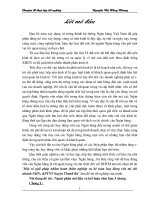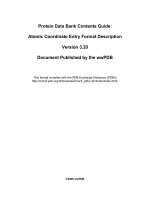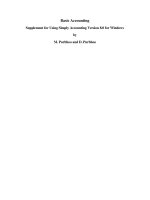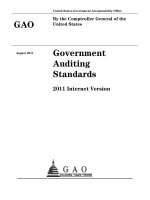Higashino yukitoshi ichimoku (eng version)
Bạn đang xem bản rút gọn của tài liệu. Xem và tải ngay bản đầy đủ của tài liệu tại đây (1.05 MB, 29 trang )
IFTA 23rd Annual Conference
Friday, October 8, 2010
“Border Line” Pattern for the Ichimoku
Kinko Hyo (Candlestick Chart)
- Positioning with 26 Base Lines and Timing for
Time--Based Loss CuttingTime
Cutting-
Yukitoshi Higashino, MFTA
1
Five Factors of the Ichimoku Kinko Hyo (hereinafter Candlestick Chart)
S&P500 (daily chart: June 2009 to August 2010)
(P)
1250
April 26
Conversion line
Conversion line, base line, leading span 1,
leading span 2, and lagging span are the five
factors of the candlestick chart, and a chart
showing those five factors is the “kinko hyo”
(equilibrium chart).
1200
1150
Leading span 1
1219.80
Aug. 9
1129.24
1100
1050
Feb. 5
1000
1044.50
July 1
1010.91
Leading span 2
950
900
Lagging span
Base line
July 8
850
869.32
2
2010/9
2010/9
2010/8
2010/7
2010/6
2010/5
2010/4
2010/3
2010/2
2010/1
2009/12
2009/11
2009/10
2009/9
2009/8
2009/7
2009/6
2009/6
800
Ideal Top and Bottom Pattern in a Candlestick Chart
Double bottom
Double top
c
a
26
26
d
b
The ideal period from a low price “a” to “b” and from a
high price “c” to “d” is within 26 days.
Why?
3
Bottom Pattern Shifting from Fall to Rise
Stock price
Ⅰ
a
26
26
△
Starting from the expected low "a,"
the price falls to "b" which is higher
than “a” and then rises, but in a
period that exceeds 26 days.
b
Ⅲ
a
×
Within 26 days from the
expected low "a," the price goes
below "a" to "b" before turning
upwards.
b
26
Ⅱ
a
○
Within 26 days from the
expected low "a," the price goes
above “a” to “b” before turning
upwards.
b
4
Ceiling Pattern for Shifting from Rise to Fall
c
26
d
Ⅰ
○
The price goes to lower “d” than
the expected high "c" within 26
days and then goes down.
×
The price goes to the higher “d”
than the expected high "c" within
26 days and then goes down.
△
The price does not exceed the
expected high "c" and goes down
after hitting "d" but in a period of
over 26 days from "c."
d
c
26
Ⅱ
c
26
d
Ⅲ
5
Important Points in Base line and Lagging Span
・ “Border line” - The ideal top-bottom pattern that
introduces the daily change concept of “26 days” from the
base line to the lagging span.
Base line: the middle price between the highest and
lowest price in the past 26 days including the current
day (highest price in a period of 26 days + lowest price
in a period of 26 days) ÷2
Lagging span: current day’s closing price projected into
the past by 26 days including the current day
6
What is the “Base Line”?
DAX and base line (daily chart: March 2010 to August 2010)
6600
26 days
April 26
6341.52
6400
6200
6000
5800
July 5
5809.37
May 25
5600
5607.68
Base line = (highest + lowest in the past 26 days)/2
On the following day, the same calculation is
conducted by including the prices of the new day
but excluding the prices of the oldest day in the base
line calculation period.
7
2010/10
2010/9
2010/8
2010/7
2010/6
2010/5
2010/4
2010/3
2010/3
* “26” used here is the important basic value in the concept of the kinko hyo (candlestick chart).
5400
What is the “Lagging Span”?
SX5E and lagging span (daily chart: May 2009 to August 2010)
3200
Upturn
Downturn
Downturn
Jan. 11
April 16
3044.37
3027.14
3000
Aug. 5
2849.45
2800
Nov. 3
2600
2693.80
Feb. 8
2617.77
Upturn
2400
May 25
2448.10
2200
A line connecting daily values in the past 26 days including today’s closing
* “26” used here is the important basic value in the concept of the kinko hyo (candlestick chart).
8
2010/10
2010/9
2010/8
2010/7
2010/6
2010/5
2010/4
2010/3
2010/3
2010/2
2010/1
2009/12
2009/11
2009/10
2009/9
2009/8
2009/7
2009/6
2009/5
2000
What the “base line” means in the border line.
・Base line: (highest in 26 days + lowest in 26 days) ÷2
Base line
○
Ⅰ
Stock price
a
26
b
×
Ⅱ
a
26
b
△
Ⅲ
a
26
b
9
When the price makes an upturn
within 26 days from the expected low
"a," the base line goes up in 26 days
from the expected low "a," and
therefore stock prices tend to go up.
When the price goes below the
expected low "a" within 26 days from
"a," the base line cannot go up and
provides resistance to the increase in
stock prices, which increases the
possibility of the price going down.
When the price does not go down
below the expected low "a" and makes
an upturn after a period of 26 days, the
base line moves sideways and then
drops to become resistant to the rising
of stock prices.
The softer the downtrend, the stronger the market (base line). Why is that?
Stock price
Base line
When a dip to "b" is strong relative to the
expected low "a," the leveling period of
the base line tends to be extended. In that
period, if the stock price does not go back
up and exceed the high, the high of the
base line during the calculation period
becomes lower, thereby causing the base
line to drop again.
Ⅰ
a
26
b
When a dip to "b" is weak relative to the
expected low "a," it is relatively more likely
that the price will go up above the recovery
high. Therefore, the high of the base line
during the calculation period go higher, and
the uptrend of the base line continues,
making it likely to create a stronger market.
Ⅱ
b
a
26
10
What the “lagging span” means in the border line.
・Lagging span: current day’s daily closing price projected into the past by 26 days
Stock price
○
Ⅰ
Lagging span
a
26
b
×
Ⅱ
26
a
b
△
Ⅲ
a
26
b
11
When the price makes an upturn
within 26 days from the expected low
"a" after hitting "b," then the lagging
span exceeds the stock price. (upturn
or buy signal).
When the price hits "b," which is
lower than the expected low "a"
within 26 days from "a," then the
lagging span remains below the stock
price. (continued downturn or sell
signal).
When the price does not go down
below the expected low "a" but takes
an upturn after hitting "b" in a period
of over 26 days from "a," the lagging
span is highly likely to go down below
the stock price again. (downturn after
upturn, sell signal).
The softer the downtrend, the stronger the market (lagging span). Why is that?
Stock price
Lagging span
When the dip to "b" is strong relative to
the expected low "a," the lagging span
tends to touch the stock price of 26 days
ago and thus is more likely to fall below
the stock price. There is a high
possibility of becoming a downturn.
Ⅰ
a
26
Ⅱ
b
When the dip to "b" is soft relative to
the expected low "a," the lagging span
tends not to touch the stock price of 26
days ago and is thus relatively less likely
to fall below the stock price. There is a
low possibility of becoming a
downturn.
b
a
26
12
Basic Pattern for the Border Line
・ The border line is composed of the ideal patterns of the lagging
line and the base line.
△
△
Stock price
Lagging span
Base line
a
26
b
c
26
d
An ideal case is that the
line does not go down
below the base line and
makes an upturn in
about 26 days from the
second lowest bottom.
26
An ideal case is that
the line does not go
up above the base line
but drops again about
26 days from the
second highest peak.
26
▽
▽
13
The Strong Border Line Pattern and the Temporal Loss Cut
・ The value goes above or falls below the recovery high or the immediate low within 26 days.
26
The base line continues to rise,
and the stock price shows a
strong up trend.
△
▽
△
△
Stock price
Lagging span
Base line
a
26
b
c
26
d
26
26
▽ Loss cutting due to the fall of the base line
△ Loss cutting due to the rise of the base line
▽
▽
The base line continues to fall,
and the stock price shows a
strong down trend.
26
14
△
▽
E Calculation after the Border Line (Setting of the Target)
3E
E
=
=
=
26
800
1000
= 50
950
750
900
E
850
= 50
800
=
=
=
26
3E
700
650
600
A rise from the second lowest bottom or a drop from the second highest
peak is often accompanied by a gap.
Double of the increment or decrement of the initial move becomes an
equilibrium point.
15
Equilibrium Point is the Arrangement of the Lateral Axis and Vertical Axis.
・ Basic values
(9, 17, 26, 33, 42, 51, 65, 76,
65
=
83, 97, 101, 129…)
=
Equilibrium point (important
change day)
76
=
42
=
Stock price
=
No. of days
26
・ Equivalent
values
168
② 53+29-1
=
③ 29+88-1
④ 53+29+88-2
29
81
=
=
88
116
53
53
③
②
①
④
Equilibrium point (important
change day)
=
Stock price
168 (53+29+88-2)
=
26
16
No. of days
Time Theory (Concept of Equivalent Value)
V=I
V=V
V=N
N=I
N=V
N=N
17
=
I =N
=
=
I =V
=
=
=
I =I
Itochu Corp. (8001, daily chart)
January 2003 to November 2003
65
64
52
351
348
347
39
39
26
39
△
△
●
Low within 26 days
26
18
Nomura Holdings, Inc. (8604、daily chart)
November 2002 to September 2003
89
90
1803
1800
179
179
179
26
179
●
26
19
△
Marubeni Corp. (8002、daily chart)
26
High within 26 days
March 2008 to March 2009
●
102
102
102
102
102
102
102
274
129
20
260
AAPL UW (daily chart、Feb. 2008 to April 2009)
48
●
19.73
19.73
120
19.73
100
19.73
80
19.73
73.86
Sept. 18, 2008
120.70
08/8/21
08/7/24
08/6/25
08/5/28
08/4/29
08/4/1
08/3/3
60
08/2/1
Jan. 20, 2009
173
21
78.20
09/4/30
19.73
09/4/10
140
152.91
09/3/13
152.78
09/2/12
160
09/1/14
180
08/12/15
192.24
February 2008 to April 2009
08/11/14
May 14, 2008
08/10/17
200
48
08/9/19
($)
Sumitomo Metal Mining (5713、 daily chart )
150(08.3.24)
45
151
1632
1626
46
270
77
270
1079
1092
1095
270
270
August 2008 to July 2009
26
22
Sumitomo Metal Mining (5713、 daily chart )
May 2010 to September 2010
26
26
23
26
NTT DOCOMO(9437、 daily chart )
October 2009 to August 2010
26
26
26
26
24
Deutsche Bank ( daily chart )
70
€
October 2008 to September 2010
2010.4.15
60.55
2009.10.15
58.37
60
49.78
50
58.29
2009.7.27
2009.6.5
8.6
52.60
49.62
8.6
40
8.6
30
8.6
8.6
95
25
10/10
10/8
10/7
10/6
10/4
10/3
10/1
09/6
09/5
09/3
09/2
08/12
08/11
08/10
10
09/12
189
15.38
09/10
●
09/9
2009.1.21
09/8
20









